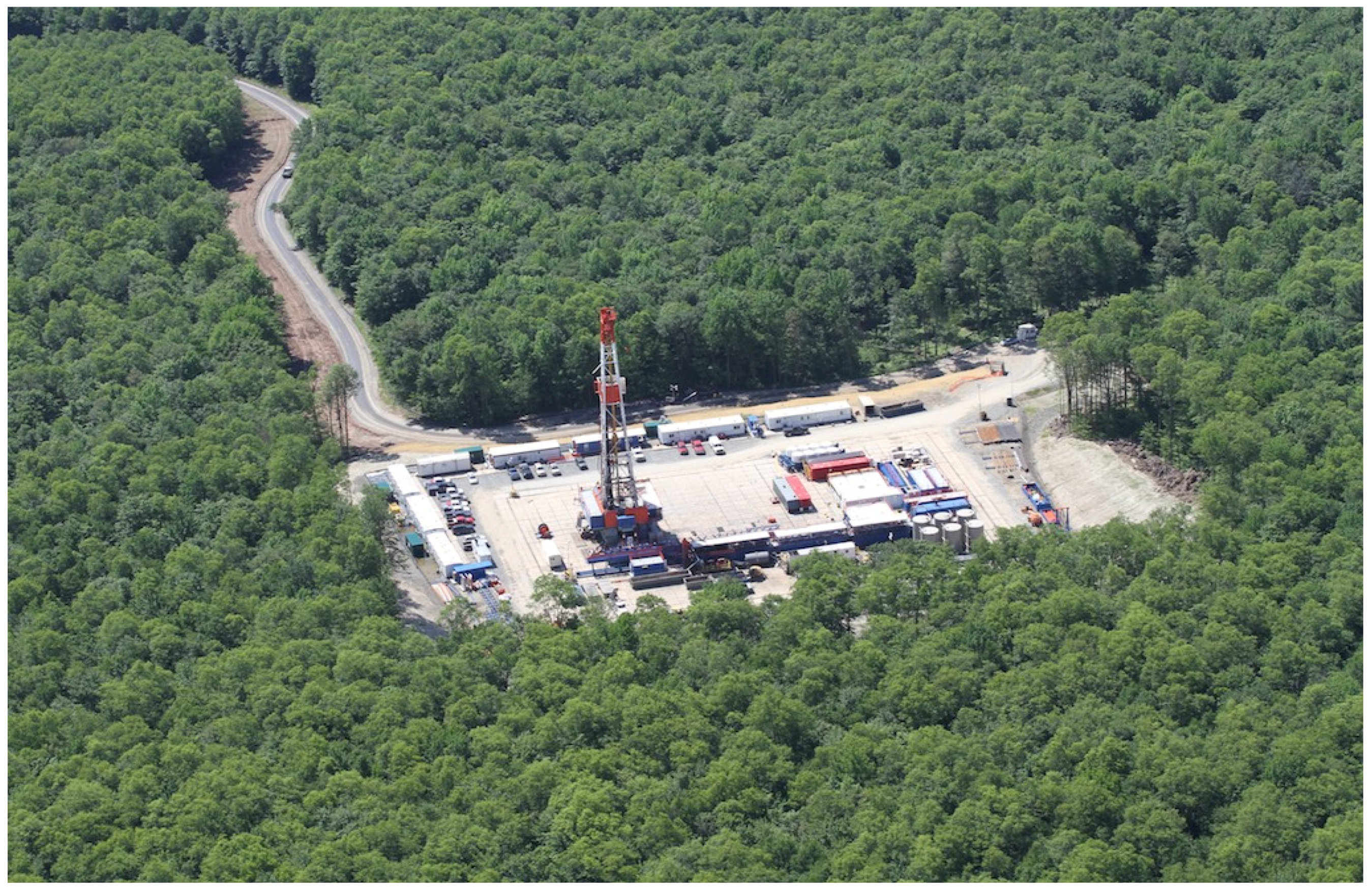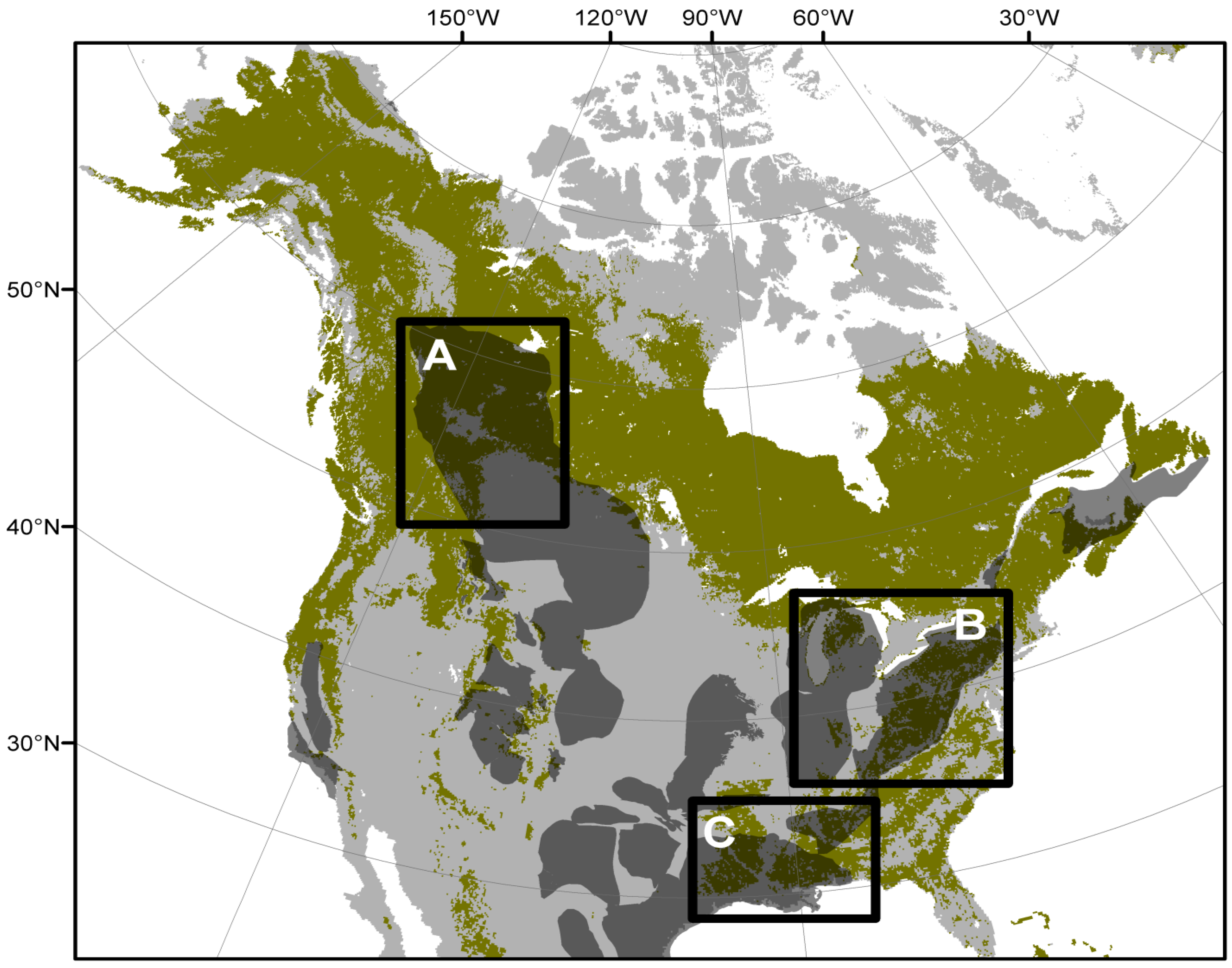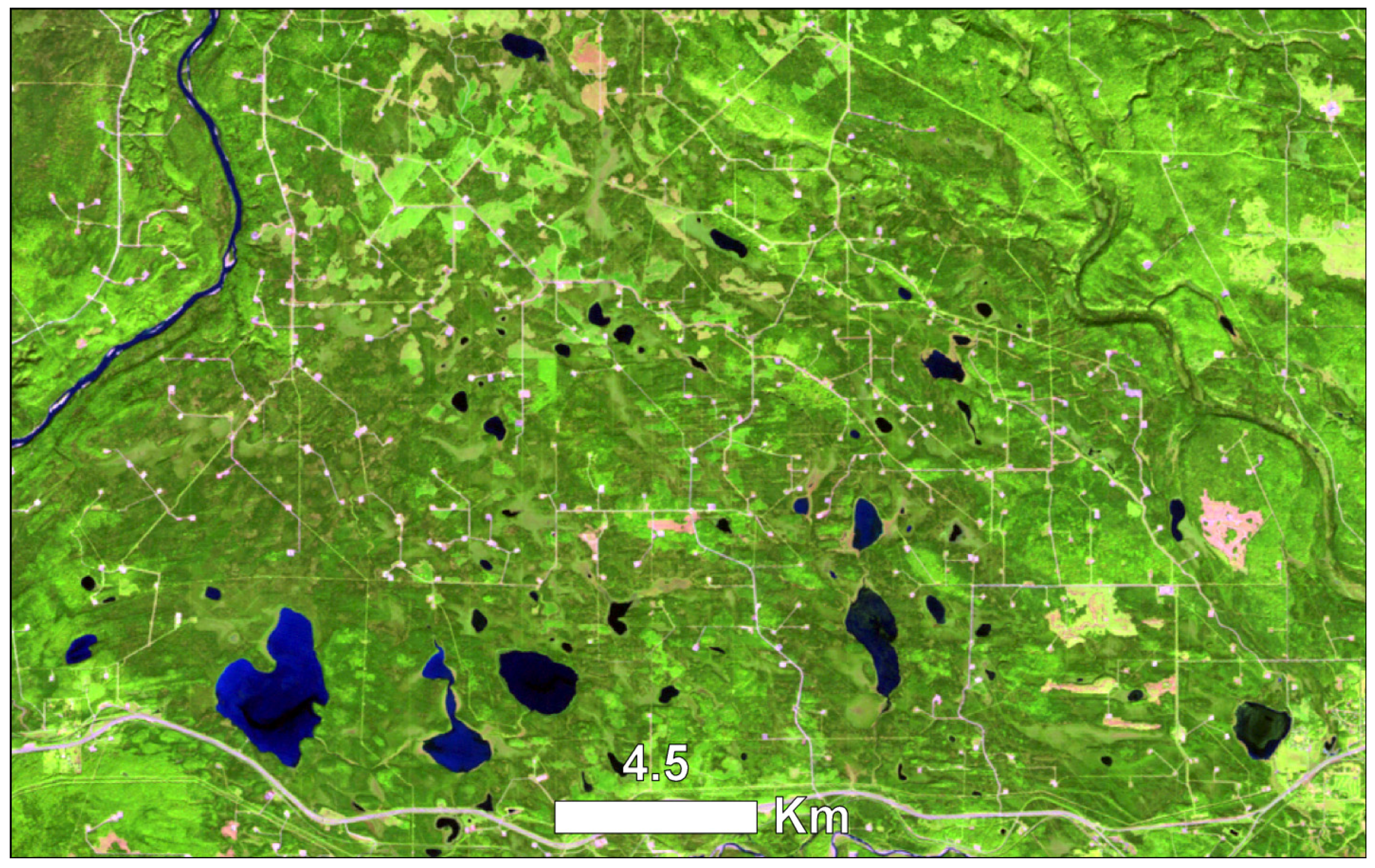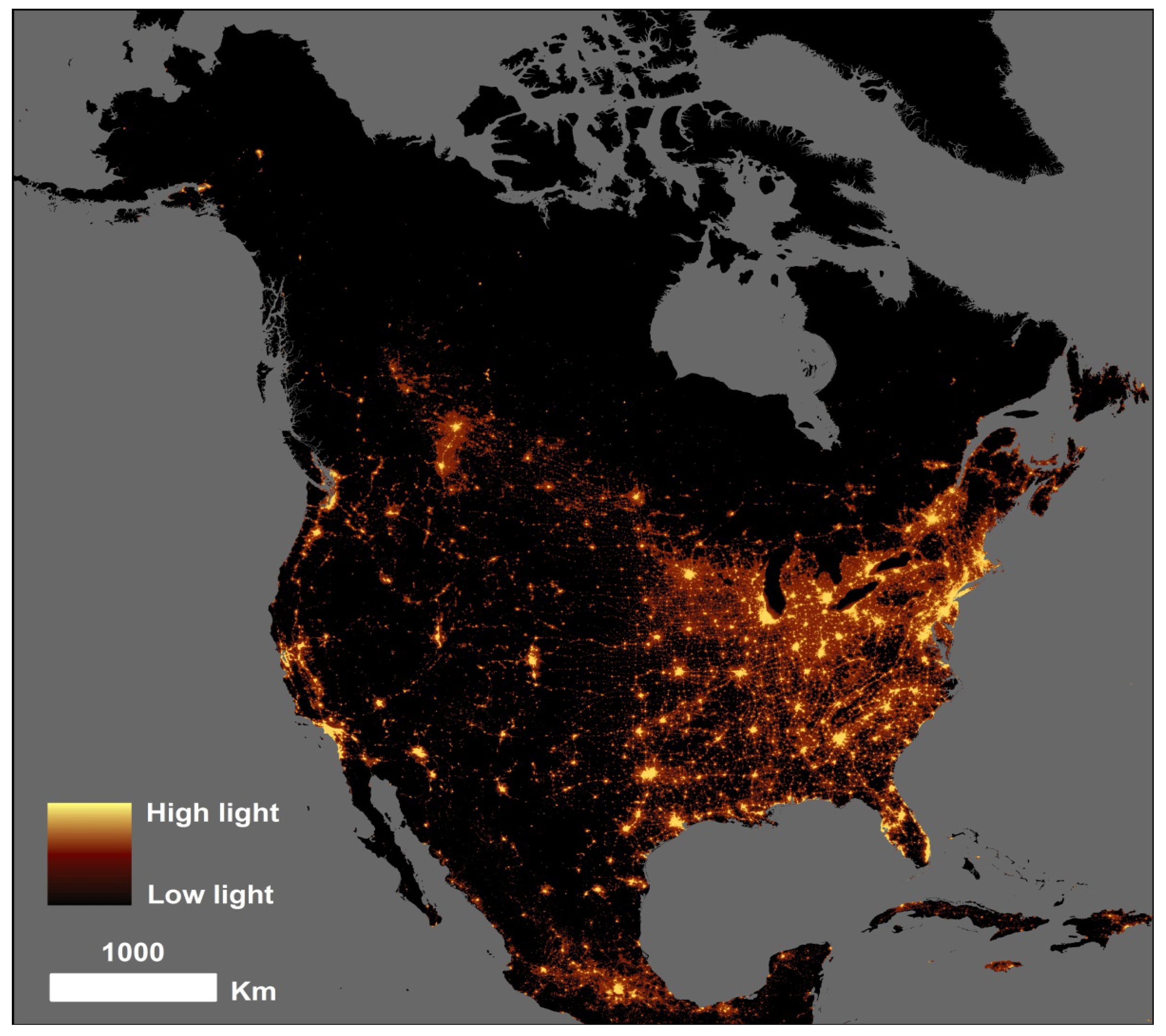Monitoring Forest Change in Landscapes Under-Going Rapid Energy Development: Challenges and New Perspectives
Abstract
:1. Introduction
2. Conceptualizing Forest Land Use as a Disturbance Regime
2.1. Defining Anthropogenic Disturbance
2.2. Challenges for Characterizing Anthropogenic Disturbance Regimes
- extent
- severity
- persistence
- intensity
- frequency
- and seasonality.

3. Ecological Impacts of Energy Development
3.1. Clearing of Forest for Non-Renewable Resources


3.2. Persistent Linear Corridors
3.3. Suppression of Historical Disturbance Regimes
| Type of Disturbance | Ecosystem Services Impact | Example | References |
|---|---|---|---|
| Surface mining | Carbon storage | Permanent peatland loss from oil sands mining in Alberta will release between 11.4 and 47.3 Mt∙C. Poor productivity for abandoned mining sites leading to a conversion from a carbon sink (forest) to a source (mine). | [26,30] |
| Water purification | Acid mine drainage and runoff, heavy metal contamination, and high concentrations of dissolved solids associated with coal mining. Seepage of heavy metals from more than 12,000 ha of tailing ponds associated with the oil sands mines into the Athabasca watershed, estimated at 11 million L/day. | [26,27,28] | |
| Pipelines | Erosion control Storm surge and flood buffering | Dredging of the Mississippi River delta plain for navigation and pipelines has resulted in significant loss of native marsh vegetation due to high influx of salt water, which has also increased erosion of the delta. | [61] |
| Seismic lines | Carbon storage Subsistence resources | After 35 years, most seismic lines in Alberta had not recovered to a forested condition, thus reducing carbon storage of the forest. Caribou (Ranger) avoid linear features, presumably due to increased risk of predation by wolves, although the association between caribou mortality and distance to linear features like seismic lines remains disputed. | [20,32,33,34] |
| Well sites | Water purification Carbon storage Subsistence resources | Methane contamination of drinking water from hydraulic fracturing in the Marcellus and Utica shale formations of Pennsylvania. Poor productivity of abandoned well sites and the conversion of a carbon sink (forest) to a source (producing well site). Ungulates have been observed to avoid industrial features like well sites, thus resulting in functional loss of otherwise suitable habitat. | [29,31,32,35] |
3.4. Introduction of Novel Ecosystems
3.5. Eradication of Ecological Memory
4. Detecting Anthropogenic Disturbance Regimes

5. Implications and Conclusions
Acknowledgments
Author Contributions
Conflicts of Interest
References
- Shvidenko, A.; Barber, C.V.; Persson, R.; Gonzalez, P.; Hassan, R.; Lakyda, P.; McCallum, I.; Milsson, S.; Pulhin, J.; van Rosenburg, B.; et al. Chapter 21: Forest and woodland systems. In The Millennium Ecosystem Assessment Series, Ecosystems and Human Well-Being: Current State and Trends; Hassan, R., Scholes, R., Ash, N., Eds.; Island Press: Washington, DC, USA, 2005; Volume 1, pp. 585–621. [Google Scholar]
- Food and Agriculture Organization of the United Nations (FAO-UN). Global Forest Resources Assessment 2010; FAO Forestry Paper 163; FAO: Rome, Italy, 2010. Available online: http://www.fao.org/docrep/013/i1757e/i1757e.pdf (accessed on 5 March 2014).
- Aide, T.M.; Clark, M.L.; Grau, H.R.; López-Carr, D.; Levy, M.A.; Redo, D.; Bonilla-Moheno, M.; Riner, G.; Andrade-Núñez, M.J.; Muñiz, M. Deforestation and reforestation of Latin America and the Caribbean (2001–2010). Biotropica 2013, 45, 262–271. [Google Scholar] [CrossRef]
- Barbier, E.B.; Burgess, J.C.; Grainger, A. The forest transition: Towards a more comprehensive theoretical framework. Land Use Policy 2010, 27, 98–107. [Google Scholar] [CrossRef]
- Marris, E.; Mascaro, J.; Ellis, E.C. Perspective: Is everything a novel ecosystem? If so, do we need the concept? In Novel Ecosystems: Intervening in the New Ecological World Order, 1st ed.; Hobbs, R.J., Higgs, E.S., Hall, C.M., Eds.; Wiley-Blackwell: West Sussex, UK, 2013; pp. 345–349. [Google Scholar]
- Harden, C.P.; Chin, A.; English, M.R.; Fu, R.; Galvin, K.A.; Gerlak, A.K.; McDowell, P.F.; McNamara, D.E.; Peterson, J.M.; Poff, N.L.; et al. Understanding human-landscape interactions in the “Anthropocene”. Environ. Manag. 2014, 53, 4–13. [Google Scholar]
- Ellis, E.C. Anthropogenic transformation of the terrestrial biosphere. Philos. Trans. Royal. Soc. A 2011, 369, 1010–1035. [Google Scholar] [CrossRef]
- Ellis, E.C.; Goldewijk, K.K.; Siebert, S.; Lightman, D.; Ramankutty, N. Anthropogenic transformation of the biomes, 1700 to 2000. Glob. Ecol. Biogeogr. 2010, 19, 589–606. [Google Scholar]
- Smith, B.D. The ultimate ecosystem engineers. Science 2007, 315, 1797–1798. [Google Scholar] [CrossRef]
- Foley, J.A.; DeFries, R.; Asner, G.P.; Barford, C.; Bonan, G.; Carpenter, S.R.; Chapin, F.S.; Coe, M.T.; Daily, G.C.; Gibbs, H.K.; et al. Global consequences of land use. Science 2005, 309, 570–574. [Google Scholar] [CrossRef]
- Steffen, W.; Crutzen, P.J.; McNeill, J.R. The Anthropocene: Are humans now overwhelming the great forests of Nature? Ambio 2007, 36, 614–621. [Google Scholar] [CrossRef]
- Crutzen, P.J.; Stoermer, E.F. The “Anthropocene”. Glob. Chang. Newsl. 2000, 41, 17–18. [Google Scholar]
- Ellis, E.C.; Haff, P.K. Earth science in the Anthropocene: New epoch, new paradigm, new responsibilities. Eos 2009, 90, 473–474. [Google Scholar] [CrossRef]
- Ellis, E.C.; Ramankutty, N. Putting people in the map: Anthropogenic biomes of the world. Front. Ecol. Environ. 2008, 6, 439–447. [Google Scholar] [CrossRef]
- McDaniel, C.N.; Borton, D.N. Increased human energy use causes biological diversity loss and undermines prospects for sustainability. BioScience 2002, 52, 929–936. [Google Scholar] [CrossRef]
- Butt, N.; Beyer, H.L.; Bennett, J.R.; Biggs, D.; Maggini, R.; Mills, M.; Renwick, A.R.; Seabrook, L.M.; Possingham, H.P. Biodiversity risks from fossil fuel extraction. Science 2013, 342, 425–426. [Google Scholar] [CrossRef]
- White, P.S.; Pickett, S.T.A. Natural disturbance and patch dynamics: An introduction. In The Ecology of Natural Disturbance and Patch Dynamics; Pickett, S.T.A., White, P.S., Eds.; Academic: New York, NY, USA, 1985; pp. 3–13. [Google Scholar]
- Heilmann, G.E., Jr.; Strittholt, J.R.; Slosser, N.C.; Dellasala, D.A. Forest fragmentation of the conterminous United States: Assessing forest intactness through road density and spatial characteristics. Bioscience 2002, 52, 411–422. [Google Scholar] [CrossRef]
- Oliver, C.D.; Larson, B.C. Forest Stand Dynamics; Wiley: New York, NY, USA, 1996. [Google Scholar]
- Lee, P.; Boutin, S. Persistence and developmental transition of wide seismic lines in the western Boreal Plains of Canada. J. Environ. Manag. 2006, 78, 240–250. [Google Scholar] [CrossRef]
- Odum, E.P. The strategy of ecosystem development. Science 1969, 164, 262–270. [Google Scholar]
- Bernstein, R.; Eros, M.; Quintana-Velázquez, M. Mineral Facilities of Latin America and Canada. United States Geological Survey; Open-File Report 2006–1375; Available online: http://pubs.usgs.gov/of/2006/1375/pdf/ofr2006-1375-table.pdf (accessed on 4 March 2014).
- Johnson, E.A.; Miyanishi, K. Creating new landscapes and ecosystems: The Alberta oil sands. Ann. N.Y. Acad. Sci. 2008, 1134, 120–145. [Google Scholar] [CrossRef]
- Pasher, J.; Seed, E.; Duffe, J. Development of boreal ecosystem anthropogenic disturbance layers for Canada based on 2008 to 2010 Landsat imagery. Can. J. Remote Sens. 2013, 39, 1–17. [Google Scholar] [CrossRef]
- United States Department of the Interior, Bureau of Land Management. Oil and gas; Well stimulation, including hydraulic fracturing, on federal and Indian lands. Fed. Regist. 2013, 78, 31635–31677. [Google Scholar]
- Rathore, C.S.; Wright, R. Monitoring environmental impacts of surface coal mining. Int. J. Remote Sens. 1993, 14, 1021–1042. [Google Scholar] [CrossRef]
- Timoney, K.P.; Lee, P. Does the Alberta tar sands pollute? The scientific evidence. Open Conserv. Biol. J. 2009, 3, 65–81. [Google Scholar] [CrossRef]
- Kelly, E.N.; Schindler, D.W.; Hodson, P.V.; Short, J.W.; Radmanovich, R.; Nielsen, C.C. Oil sands development contributes elements toxic at low concentrations to the Athabasca River and its tributaries. Proc. Nat. Acad. Sci. USA 2010, 107, 16178–16183. [Google Scholar]
- Osborn, S.G.; Vengosh, A.; Warner, N.R.; Jackson, R.B. Methane contamination of drinking water accompanying gas-well drilling and hydraulic fracturing. Proc. Nat. Acad. Sci. USA 2011, 108, 8172–8176. [Google Scholar] [CrossRef]
- Rooney, R.C.; Bayley, S.E.; Schindler, D.W. Oil sands mining and reclamation cause massive loss of peatland and stored carbon. Proc. Natl. Acad. Sci. USA 2012, 109, 4933–4937. [Google Scholar] [CrossRef]
- MacFarlane, A.K. Revegetation of Wellsites and Seismic Lines in the Boreal Forest. Bachelor’s Thesis, University of Alberta, Edmonton, AL, Canada, 1999. [Google Scholar]
- Dyer, S.T.; O’Neill, J.P.; Wasel, S.M.; Boutin, S. Avoidance of industrial development by woodland caribou. J. Wildl. Manag. 2001, 65, 531–542. [Google Scholar] [CrossRef]
- Latham, D.M.; Latham, M.C.; Boyce, M.S.; Boutin, S. Movement responses by wolves to industrial linear features and their effect on woodland caribou in northeastern Alberta. Ecol. Appl. 2011, 21, 2854–2865. [Google Scholar] [CrossRef]
- James, A.R.C.; Stuart-Smith, A.K. Distribution of caribou and wolves in relation to linear corridors. J. Wildl. Manag. 2000, 64, 154–159. [Google Scholar] [CrossRef]
- Sawyer, H.; Nielson, R.M.; Lindzey, F.; McDonald, L.L. Winter habitat selection of mule deer before and during development of a natural gas field. J. Wildl. Manag. 2006, 70, 396–403. [Google Scholar] [CrossRef]
- Smyth, C.R.; Dearden, P. Performance standards and monitoring requirements of surface mine reclamation success in mountainous jurisdictions of western North America: A review. J. Environ. Manag. 1998, 53, 209–229. [Google Scholar] [CrossRef]
- Alberta Environment and Sustainable Resource Development. Drilled, Abandoned and Reclaimed Well in Alberta, 1963–2012. Available online: http://esrd.alberta.ca/focus/state-of-the-environment/land/response-indicators/oil-and-gas-wells-reclamation.aspx (accessed on 10 June 2014).
- Timoney, K.; Lee, P. Environmental management in resource-rich Alberta, Canada: First world jurisdiction, third world analogue? J. Environ. Manag. 2001, 63, 387–405. [Google Scholar] [CrossRef]
- Interstate Natural Gas Association of America (INGAA). North American Midstream Infrastructure through 2035: Capitalizing on our Energy Abundance. Technical Report. 2014. Available online: http://www.ingaa.org/File.aspx?id=21498 (accessed on 27 May 2014).
- Parfomak, P.W.; Pirog, R.; Luther, L.; Vann, A. Keystone XL Pipeline Project: Key Issues; Congressional Research Service: Washington, D.C., USA. Available online: http://digitalcommons.ilr.cornell.edu/key_workplace/1011/ (accessed on 4 June 2014).
- Hebblewhite, M.; White, C.A.; Nietvelt, C.G.; McKenzie, J.A.; Hurd, T.E.; Fryxell, J.M.; Bayley, S.E.; Paquet, P.C. Human activity mediates a trophic cascade caused by wolves. Ecology 2005, 86, 2135–2144. [Google Scholar] [CrossRef]
- Lesmerises, F.; Dussault, C.; St-Laurent, M.-H. Wolf habitat selection is shaped by human activities in a highly managed boreal forest. For. Ecol. Manag. 2012, 276, 125–131. [Google Scholar] [CrossRef]
- Lesmerises, F.; Dussault, C.; St-Laurent, M.-H. Major roadwork impacts the space use behavior of gray wolf. Landsc. Urban Plan. 2013, 112, 18–25. [Google Scholar] [CrossRef]
- Leblond, M.; Dussault, C.; Ouellet, J.-P. Avoidance of roads by large herbivores and its relation to disturbance intensity. J. Zool. 2013, 289, 32–40. [Google Scholar] [CrossRef]
- Haines-Young, R.; Chopping, M. Quantifying landscape structure: A review of landscape indices and their application to forested landscapes. Prog. Phys. Geogr. 1996, 20, 418–445. [Google Scholar] [CrossRef]
- MacFarlane, A.K. Vegetation Response to Seismic Lines: Edge Effects and on-Line Succession. Master’s Thesis, University of Alberta, Edmonton, AL, Canada, 2003. [Google Scholar]
- Morgan, P.; Aplet, G.H.; Haufler, J.B.; Humphries, H.C.; Moore, M.M.; Wilson, W.D. Historical range of variability. J. Sustain. For. 1994, 2, 87–111. [Google Scholar]
- Landres, P.B.; Morgan, P.; Swanson, F.J. Overview of the use of natural variability concepts in managing ecological systems. Ecol. Appl. 1999, 9, 1179–1188. [Google Scholar]
- British Columbia Ministry of Forests, Lands and Natural Resource Operations, Wildfire Management Branch. Wildfire Management Strategy 2010. Available online: http://bcwildfire.ca/prevention/PrescribedFire/docs/BCWFMS.pdf (accessed on 5 March 2014).
- Gorte, R. The Rising Cost of Wildfire Protection. Headwater Economics. Available online: http://headwaterseconomics.org/wphw/wp-content/uploads/fire-costs-background-report.pdf (accessed on 5 March 2014).
- Taylor, S.W.; Stennes, B.; Wang, S.; Taudin-Chabot, P. Integrating Canadian wildland fire management policy and institutions: Sustaining natural resources, communities and ecosystems. In Canadian Wildland Fire Strategy: Background Syntheses, Analyses, and Perspectives; Hirsch, K.G., Fuglem, P., Eds.; Natural Resources Canada: Edmonton, AL, Canada, 2006; pp. 3–25. [Google Scholar]
- Gould, J.S.; Patriquin, M.N.; Wang, S.; McFarlane, B.L.; Wotton, B.M. Economic evaluation of research to improve the Canadian forest fire danger system. Forestry 2013, 86, 317–329. [Google Scholar] [CrossRef]
- Donovan, G.H.; Brown, T.C. Be careful what you wish for: The legacy of Smokey Bear. Front. Ecol. Environ. 2007, 5, 73–79. [Google Scholar] [CrossRef]
- Cumming, S.G. Effective fire suppression in boreal forests. Can. J. For. Res. 2005, 35, 772–786. [Google Scholar] [CrossRef]
- British Columbia Ministry of Forests, Lands and Natural Resource Operations, Wildfire Management Branch. Wildfire Management Branch Strategic Plan 2012–2017. Available online: http://bcwildfire.ca/Strategic_Planning/docs/Wildfire%20Management%20Strategic%20Plan%202012_17.pdf (accessed on 5 March 2014).
- Stephens, S.L.; Ruth, L.W. Federal forest-fire policy in the United States. Ecol. Appl. 2005, 15, 532–542. [Google Scholar] [CrossRef]
- Bridge, S.R.J.; Miyanishi, K.; Johnson, E.A. A critical evaluation of fire suppression effects in the boreal forest of Ontario. For. Sci. 2004, 51, 41–50. [Google Scholar]
- Andison, D.W.; McCleary, K. Detecting regional differences in with-wildfire burn patterns in western boreal Canada. For. Chron. 2014, 90, 59–69. [Google Scholar] [CrossRef]
- Andison, D.W. The influence of wildfire boundary delineation on our understanding of burning patterns in the Alberta foothills. Can. J. For. Res. 2012, 42, 1253–1263. [Google Scholar] [CrossRef]
- Foy, G. Oil and gas activity and Louisiana wetland loss. J. Environ. Manag. 1990, 31, 289–297. [Google Scholar] [CrossRef]
- Barbier, E.B. Coastal wetland restoration and the Deepwater Horizon oil spill. Vanderbilt Law Rev. 2011, 64, 1819–1850. [Google Scholar]
- U.S. Energy Information Administration. Natural Gas Annual Supply and Disposition by State. Available online: http://www.eia.gov/dnav/ng/ng_sum_snd_a_EPG0_FPD_Mmcf_a.htm (accessed on 30 May 2014).
- Mendelssohn, I.A.; Anderson, G.L.; Baltz, D.M.; Caffey, R.H.; Carman, K.R.; Fleeger, J.W.; Joye, S.B.; Lin, Q.; Maltby, E.; Overton, E.B.; et al. Oil impacts on coastal wetlands: Implications for the Mississippi River delta ecosystem after the Deepwater Horizon oil spill. Bioscience 2012, 62, 562–574. [Google Scholar] [CrossRef]
- Mack, R.N.; Simberloff, S.; Lonsdale, W.M.; Evans, H.; Clout, M.; Bazzaz, F. Biotic invasions: Causes, epidemiology, global consequences and control. Issues Ecol. 2000, 5, 1–20. [Google Scholar]
- Schneider, R.R.; Stelfox, J.B.; Boutin, S.; Wasel, S. Managing the cumulative impacts of land uses in the western Canadian sedimentary basin: A modeling approach. Conserv. Ecol. 2003, 7, 8. [Google Scholar]
- Ricciardi, A.; Hoopes, M.F.; Marchetti, M.P.; Lockwood, J.L. Progress toward understanding the ecological impacts of nonnative species. Ecol. Monogr. 2013, 83, 263–282. [Google Scholar] [CrossRef]
- Laliberte, A.S.; Ripple, W.J. Range contractions of North American carnivores and ungulates. BioScience 2004, 54, 123–138. [Google Scholar] [CrossRef]
- Laberee, K.; Nelson, T.A.; Stewart, B.P.; McKay, T.; Stenhouse, G.B. Oil and gas infrastructure and the spatial pattern of grizzly bear habitat selection in Alberta, Canada. Can. Geogr. 2014, 58, 79–94. [Google Scholar] [CrossRef]
- Hairston, B.G.; Smith, F.E.; Slobodkin, L.B. Community structure, population control, and competition. Am. Nat. 1960, 94, 421–425. [Google Scholar]
- Beschta, R.L. Reduced cottonwood recruitment following extirpation of wolves in Yellowstone’s northern range. Ecology 2005, 86, 391–403. [Google Scholar] [CrossRef]
- Ripple, W.J.; Larsen, E.J. Historic aspen recruitment, elk, and wolves in northern Yellowstone National Park, USA. Biol. Conserv. 2000, 95, 361–370. [Google Scholar] [CrossRef]
- Kauffman, M.J.; Brodie, J.F.; Jules, E.S. Are wolves saving Yellowstone’s aspen? A landscape-level test of a behaviorally mediated trophic cascade. Ecology 2010, 91, 2742–2755. [Google Scholar] [CrossRef]
- Marris, E. Rethinking predators: Legend of the wolf. Nature 2014, 507, 158–160. [Google Scholar] [CrossRef]
- Langor, D.W.; Spence, J.R. Arthropods as ecological indicators of sustainability in Canadian forests. For. Chron. 2006, 82, 344–350. [Google Scholar] [CrossRef]
- Buddle, C.M.; Langor, D.W.; Pohl, G.R.; Spence, J.R. Arthropod responses to harvesting and wildfire: Implications for emulation of natural disturbance in forest management. Biol. Conserv. 2006, 128, 346–357. [Google Scholar] [CrossRef]
- Spence, J.R.; Langor, D.W.; Niemelӓ, J.; Cárcamo, H.A.; Currie, C.R. Northern forestry and carabids: The case for concern about old-growth species. Ann. Zool. Fenn. 1996, 33, 173–184. [Google Scholar]
- Van Wilgenberg, S.L.; Mazerolle, D.F.; Hobson, K.A. Patterns of arthropod abundance, vegetation, and microclimate at boreal forest edge and interior in two landscapes: Implications for forest birds. Ecoscience 2001, 8, 454–461. [Google Scholar]
- Niemelӓ, J. Invertebrates and boreal forest management. Conserv. Biol. 1997, 11, 601–610. [Google Scholar]
- McCall, B.D.; Pennings, S.C. Disturbance and recovery of salt marsh arthropod communities following BP Deepwater Horizon oil spill. PLoS One 2012, 7, e32735. [Google Scholar] [CrossRef]
- Bengtsson, J.; Angelstam, P.; Elmqvist, T.; Emanualsson, U.; Folke, C.; Ihse, M.; Moberg, F.; Nyström, M. Reserves, resilience and dynamic landscapes. AMBIO 2003, 32, 389–396. [Google Scholar]
- Harmon, M.E.; Franklin, J.F.; Swanson, F.J.; Sollins, P.; Gregory, S.V.; Lattin, J.D.; Anderson, N.H.; Cline, S.P.; Aumen, N.G.; Sedell, J.R.; et al. Ecology of coarse woody debris in temperate ecosystems. Adv. Ecol. Res. 1986, 15, 133–302. [Google Scholar] [CrossRef]
- Mitchell, S.J. Wind as a natural disturbance agent in forests: A synthesis. Forestry 2013, 86, 147–157. [Google Scholar]
- Krankina, O.N.; Harmon, M.E. The impact of intensive forest management on carbon stores in forest ecosystems. World Resour. Rev. 1994, 6, 161–177. [Google Scholar]
- Krankina, O.N.; Harmon, M.E. Dynamics of the dead wood carbon pool in northwestern Russian boreal forests. Water, Air Soil Pollut. 1995, 86, 227–238. [Google Scholar] [CrossRef]
- Pedler, J.H.; Pearce, J.L.; Venier, L.A.; McKenney, D.W. Coarse woody debris in relation to disturbance and forest type in boreal Canada. Forest Ecol. Manag. 2002, 158, 189–194. [Google Scholar] [CrossRef]
- Simmons, J.A.; Currie, W.S.; Eshleman, K.N.; Kuers, K.; Monteleone, S.; Negley, T.L.; Pohlad, B.P.; Thomas, C.L. Forest to reclaimed mine land use change leads to altered ecosystem structure and function. Ecol. Appl. 2008, 18, 104–118. [Google Scholar] [CrossRef]
- Richards, R.T.; Chambers, J.C.; Ross, C. Use of native plants on federal lands: Policy and practice. J. Range Manag. 1998, 51, 625–632. [Google Scholar] [CrossRef]
- Rock, B.N.; Vogelmann, J.E.; Williams, D.L.; Vogelmann, A.F.; Hoshizaki, T. Remote detection of forest damage. BioScience 1986, 36, 439–445. [Google Scholar] [CrossRef]
- Nemani, R.; Running, S. Land cover characterization using multitemporal red, near-IR, and thermal-IR data from NOAA/AVHR. Ecol. Appl. 1997, 7, 79–90. [Google Scholar] [CrossRef]
- Healey, S.P.; Cohen, W.B.; Yang, Z.; Krankina, O.N. Comparison of tasseled cap-based Landsat data structures for use in forest disturbance detection. Remote Sens. Environ. 2005, 97, 301–310. [Google Scholar] [CrossRef]
- Kauth, R.J.; Thomas, G.S. The tasselled cap—A graphic description of the spectral-temporal development of agricultural crops as seen by Landsat. In Proceedings of the Symposium on Machine Processing of Remotely Sensed Data, West Lafayette, IN, USA, 29 June–1 July 1976.
- Woodcock, C.E.; Allen, R.; Anderson, M.; Belward, A.; Bindschadler, R.; Cohen, W.; Gao, F.; Goward, S.N.; Helder, D.; Helmer, E.; et al. Free access to Landsat imagery. Science 2008, 320, 1011–1012. [Google Scholar]
- Wulder, M.A.; White, J.C.; Goward, S.N.; Masek, J.G.; Irons, J.R.; Herold, M.; Cohen, W.B.; Loveland, T.R.; Woodcock, C.E. Landsat continuity: Issues and opportunities for land cover monitoring. Remote Sens. Environ. 2008, 112, 955–969. [Google Scholar] [CrossRef]
- Zhu, Z.; Woodcock, C.E. Continuous change detection and classification of land cover using all available Landsat data. Remote Sens. Environ. 2014, 144, 152–171. [Google Scholar] [CrossRef]
- Linke, J.; McDermid, G.J.; Laskin, D.N.; McLane, A.J.; Pape, A.; Cranston, J.; Hall-Beyer, M.; Franklin, S.E. A disturbance-inventory framework for flexible and reliable landscape monitoring. Photogramm. Eng. Remote Sens. 2009, 75, 981–995. [Google Scholar] [CrossRef]
- Linke, J.; McDermid, G.J. A conceptual model for multi-temporal landscape monitoring in an object-based environment. IEEE J. Sel. Top. Appl. Earth Obs. Remote Sens. 2011, 4, 265–271. [Google Scholar] [CrossRef]
- Linke, J.; McDermid, G.J. Monitoring landscape change in multi-use west-central Alberta, Canada using the disturbance-inventory framework. Remote Sens. Environ. 2012, 125, 112–124. [Google Scholar] [CrossRef]
- Huang, C.; Goward, S.N.; Masek, J.G.; Thomas, N.; Zhu, Z.; Vogelmann, J.E. An automated approach for reconstructing recent forest disturbance history using dense Landsat time series stacks. Remote Sens. Environ. 2010, 114, 183–198. [Google Scholar] [CrossRef]
- Kennedy, R.E.; Yang, Z.; Cohen, W.B. Detecting trends in forest disturbance and recovery using yearly Landsat time series: 1. LandTrendr—Temporal segmentation algorithms. Remote Sens. Environ. 2010, 114, 2897–2910. [Google Scholar] [CrossRef]
- Masek, J.G.; Goward, S.N.; Kennedy, R.E.; Cohen, W.B.; Moisen, G.G.; Schleeweis, K.; Huang, C. United States forest disturbance trends observed using Landsat time series. Ecosystems 2013, 16, 1087–1104. [Google Scholar] [CrossRef]
- Hansen, M.C.; Potapov, P.V.; Moore, R.; Hancher, M.; Turubanova, S.A.; Tyukavina, A.; Thau, D.; Stehman, S.V.; Goetz, S.J.; Loveland, T.R.; et al. High-resolution global maps of 21st-century forest cover change. Science 2013, 342, 850–853. [Google Scholar]
- United States Department of Agriculture, Forest Service. Fire Detection Maps. Available online: http://activefiremaps.fs.fed.us/activefiremaps.php (accessed on 12 March 2014).
- Fernández-Manso, A.; Quintano, C.; Roberts, D. Evaluation of potential of Multiple Endmember Spectral Mixture Analysis (MESMA) for surface coal mining affected area mapping in different world forest ecosystems. Remote Sens. Environ. 2012, 127, 181–193. [Google Scholar] [CrossRef]
- Townsend, P.A.; Helmers, D.P.; Kingdon, C.C.; McNeil, B.E.; de Beurs, K.M.; Eshleman, K.N. Changes in the extent of surface mining and reclamation in the central Appalachians detected using a 1976–2006 Landsat time series. Remote Sens. Environ. 2009, 113, 62–72. [Google Scholar] [CrossRef]
- Morgan, J.L.; Gergel, S.E.; Coops, N.C. Aerial photography: A rapidly evolving tool for ecological management. Bioscience 2010, 60, 47–59. [Google Scholar] [CrossRef]
- Morgan, J.L.; Gergel, S.E. Automated analysis of aerial photographs and potential for historic forest mapping. Can. J. For. Res. 2013, 43, 599–710. [Google Scholar] [CrossRef]
- Lim, K.; Treitz, P.; Wulder, M.; St-Onge, B.; Flood, M. LiDAR remote sensing of forest structure. Prog. Phys. Geogr. 2003, 27, 88–106. [Google Scholar] [CrossRef]
- Næsset, E. Predicting forest stand characteristics with airborne scanning laser using a practical two-stage procedure and field data. Remote Sens. Environ. 2002, 80, 88–99. [Google Scholar] [CrossRef]
- Small, C.; Elvidge, C.D.; Balk, D.; Montgomery, M. Spatial scaling of stable night lights. Remote Sens. Environ. 2011, 115, 269–280. [Google Scholar] [CrossRef]
- Elvidge, C.D.; Ziskin, D.; Baugh, K.E.; Tuttle, B.T.; Ghosh, T.; Pack, D.W.; Erwin, E.H.; Zhizhin, M. A fifteen year record of global natural gas flaring derived from satellite data. Energies 2009, 2, 595–622. [Google Scholar] [CrossRef]
© 2014 by the authors; licensee MDPI, Basel, Switzerland. This article is an open access article distributed under the terms and conditions of the Creative Commons Attribution license (http://creativecommons.org/licenses/by/3.0/).
Share and Cite
Pickell, P.D.; Gergel, S.E.; Coops, N.C.; Andison, D.W. Monitoring Forest Change in Landscapes Under-Going Rapid Energy Development: Challenges and New Perspectives. Land 2014, 3, 617-638. https://doi.org/10.3390/land3030617
Pickell PD, Gergel SE, Coops NC, Andison DW. Monitoring Forest Change in Landscapes Under-Going Rapid Energy Development: Challenges and New Perspectives. Land. 2014; 3(3):617-638. https://doi.org/10.3390/land3030617
Chicago/Turabian StylePickell, Paul D., Sarah E. Gergel, Nicholas C. Coops, and David W. Andison. 2014. "Monitoring Forest Change in Landscapes Under-Going Rapid Energy Development: Challenges and New Perspectives" Land 3, no. 3: 617-638. https://doi.org/10.3390/land3030617
APA StylePickell, P. D., Gergel, S. E., Coops, N. C., & Andison, D. W. (2014). Monitoring Forest Change in Landscapes Under-Going Rapid Energy Development: Challenges and New Perspectives. Land, 3(3), 617-638. https://doi.org/10.3390/land3030617







